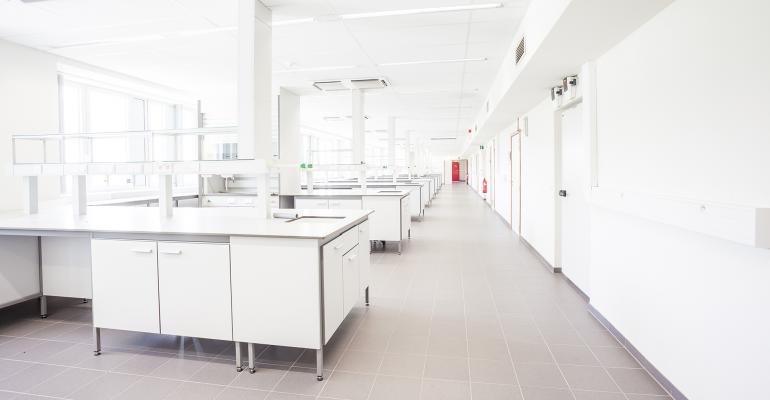Developers are quickly converting some existing office spaces, but not every building is a good fit to include laboratory space.
Investors are eager to buy life sciences buildings—which may look like conventional office properties on the outside, but contain hard-to-find laboratory space on the inside.
In about a dozen top cities where life sciences companies are located, demand is high and rents are growing quickly for lab spaces and life sciences buildings. Investors are willing to pay high prices—accepting low yields to invest in these hard-to-find properties.
In response, a growing number of investors are converting conventional office buildings to include laboratory spaces.
“They are considering converting their properties to meet immediate life science demand,” says Daniel Littman, associate director of capital markets research for Newmark, working in the firm’s offices in New York City. “Institutional investors across the largest life science markets are actively reevaluating ‘highest and best use’ for their office, flex and industrial portfolios.”
The prices investors are paying for life sciences real estate keeps rising.
“Pricing is very aggressive,” says Ian Anderson, senior director of research for CBRE, working in the firm’s offices in Philadelphia. “Cap rates below 5 percent are not uncommon for laboratory and research and development properties.”
In March 2021, Blackstone BioMed paid $3.45 billion for Brookfield’s 2.3 million-sq.-ft. portfolio of laboratory properties in Boston and Cambridge, Mass.
That price that works out to an estimated cap rate of 4.5 percent, according to CBRE. In another recent deal in South San Francisco, undisclosed investors agreed to pay more than $400 million for lab properties, at an estimated cap rate of 4.0 percent, according to Anderson.
The volume of deals that investors make to invest in life sciences properties is still tiny compared to the market for office properties overall or other major property types—even though it is growing quickly.
Investors raised more than $15 billion in 2020, led by Blackstone but also emerging players such as IQHQ and Breakthrough Properties, traditional healthcare REITs such as Ventas and institutional groups such as DivcoWest and Clarion Partners, according to Newmark’s Littman.
Investors closed over $10 billion in deals to buy life sciences properties in 2020. That added up to 16.4 percent of the dollars invested in office properties overall—a record amount, according to Newmark.
“Investors are clearly growing more comfortable with the property sector, based upon its recent performance and strong growth outlook,” says Anderson. “Less appealing choices among some conventional property types… that is driving pricing of life sciences properties higher.”
Life science looks good compared to office space overall
During the pandemic, many office workers had to stay home to slow the spread of the coronavirus. More than a year after the start of the pandemic, the number of workers coming into offices to work in person in August 2021 was still just a fraction of normal amount.
In contrast, many life sciences employees counted as essential workers and continued to come to work, even in the worst days of the pandemic. These lab workers typically can’t do their work from home. In the long-term life sciences properties seem likely to keep their value even if large numbers of office workers overall continue to spend part of the work week working remotely.
Demand for life sciences properties was also high before the pandemic. Average rents for life sciences space nearly doubled (rose more than 90 percent) in San Francisco for the five years that ended in the first quarter of 2021, according to Newmark. Life sciences rents also rose quickly in Chicago (more than 80 percent), Raleigh, N.C. (more than 80 percent) and Boston (more than 60 percent). That’s several times the rent increase for office space overall in those markets.
“In Boston, life science tenants seeking space in Cambridge are expected to have to wait nearly two years for available space,” says Littman.
Renovate the right buildings to become laboratory space
Developers are quickly converting some existing office spaces to become life sciences properties—but not every office building is a good fit to include laboratory space.
“Adding lab space to a conventional office building is certainly possible, but there can be several hurdles,” says CBRE’s Anderson.
The ceilings need to be at least 13 ft. high—more established firms like Novatis or Pfizer expect ceilings at high as 18 ft. Labs that require extensive ventilation or power systems could need even higher ceilings. Wet lab space also needs floors that can support 100 to 150 pounds per sq. ft., compared to just 80 to 100 pounds per sq. ft. for conventional office space, and a strong, uninterruptable power supply.
“Assuming the structural elements can support the conversion, I’d say assume about $100 to $150 per sq. ft. in base building costs,” says Liz Berthelette, Newmark’s head of research in Boston. Those renovations often include pH neutralization, chemical storage, MEP upgrades and loading upgrades including freight elevators. Life science tenant often perform another another $250 to $300 per sq. ft. in tenant improvements.
The building also needs to be in an area that is zoned for the types of activities undertaken in a lab. More broadly, the property needs to be in a place with demand for life sciences real estate
Companies that need laboratory space tend to locate near other life science companies and major research universities. There are roughly a dozen metropolitan areas where life science companies can hire enough qualified scientists and technicians to flourish. That includes established life science markets like Boston, San Francisco, San Diego, North Carolina, Seattle, Philadelphia, Maryland and Los Angeles, in addition to metro areas where life science hubs are developing.
“Markets such as New York City, Chicago, Houston, Denver and Austin—these places have the potential to become major life science clusters,” says Newmark’s Littman.
Source: View Original Article






